A History of the County of Northampton: Volume 3. Originally published by Victoria County History, London, 1930.
This free content was digitised by double rekeying. All rights reserved.
'Parishes: Aldwinkle St. Peter', in A History of the County of Northampton: Volume 3, ed. William Page (London, 1930), British History Online https://prod.british-history.ac.uk/vch/northants/vol3/pp168-173 [accessed 19 April 2025].
'Parishes: Aldwinkle St. Peter', in A History of the County of Northampton: Volume 3. Edited by William Page (London, 1930), British History Online, accessed April 19, 2025, https://prod.british-history.ac.uk/vch/northants/vol3/pp168-173.
"Parishes: Aldwinkle St. Peter". A History of the County of Northampton: Volume 3. Ed. William Page (London, 1930), British History Online. Web. 19 April 2025. https://prod.british-history.ac.uk/vch/northants/vol3/pp168-173.
In this section
ALDWINKLE ST. PETER
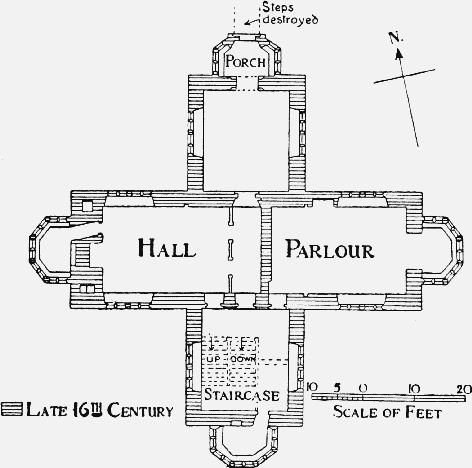
Plan of Lyveden New Building
The description of the parish of Aldwinkle St. Peter is covered by that of Aldwinkle All Saints (q.v.) to which it was united in 1879. The villages adjoin. Aldwinkle St. Peter, which is the larger, lying to the north of Aldwinkle All Saints. The present rectory house was built in 1867. The old rectory, which appears to have been a timber-framed house, was pulled down at the end of the 18th century by the first Lord Lilford. (fn. 1)
At Lyveden, where the land rises some 150 ft. from the River Nene and the country is well wooded, are the two interesting houses known as the Old Building and the New Building. The former stands on the site of an old manor house of the Treshams of Rushton. Of recent years it has been occupied as a farmhouse, and has become encumbered with farm buildings. Only a few fragments of the old house which it replaced are preserved, some built into the house itself, others into an adjacent cottage. It had an imposing Jacobean staircase and some handsome fireplaces of the same period, but the staircase has now been sold. It appears to have extended farther to the east than at present, and there was a forecourt entered through a fine archway, which, however, was taken down about the middle of last century and re-erected at the neighbouring house of Farming Woods by the then owner, Lord Lyveden. Towards the end of the 16th century, Sir Thomas Tresham of Rushton, of whom Thomas Fuller in his Worthies says 'hard to say whether greater his delight or skill in building, though more forward in beginning than fortunate in finishing his fabricks,' devised a fine lay-out at the back of the Old Building, extending some way up the hill. Remains of it still exist, particularly a long raised terrace with a mount at each end. Adjoining this is a 'canal,' part of a series which inclosed a 'water orchard.' Beyond these again, and doubtless once connected to them in the design, lies the curious New Building, one of three notable buildings erected by Sir Thomas, the others being the Triangular Lodge at Rushton and the Market House at Rothwell. Sir Thomas was a Roman Catholic and a mystic. As the former he suffered long terms of imprisonment, which incidentally gave him leisure as a mystic to elaborate many curious conceits, some of which he embodied in the Triangular Lodge and this New Building. The first is based on the number 3 and illustrates the doctrine of the Trinity. The New Building symbolises the Passion, and its design is influenced by the numbers 3, 5, 7, 9. The plan is an equal-armed cross, each arm being a square with a bay window at the end. The basement windows and shields are grouped in threes; the bay windows have five sides of 5 ft. long; the lower cornice carries seven emblems of the Passion placed in rotation; in the upper cornice were appropriate legends, parts of which remain, and they were so selected that those on each arm had eighty-one letters (nine times nine). The building was intended for a small house or 'lodge,' and it contained the usual rooms of the period, hall, parlour, great chamber, bedrooms, kitchen, pantry, larder, staircase, etc. The arch that connects the parlour with its bay window bears the arms of Sir Thomas and his wife, Muriel Throckmorton. The building is of stone and is admirably built, much of the detail being as sharp as when new. It was purchased, together with the water orchard and the long terrace, in 1922 by the National Trust for Places of Historic Interest or Natural Beauty. The walls were then protected against the weather, but no restoration was attempted. It has been a ruin from the time when it was built, for Sir Thomas died before it was completed, and immediately afterwards the house and manor (q.v.) were forfeited, as his son Francis became implicated in the Gunpowder Plot. The Lyveden estate appears to have been rescued from the general disaster, for the Old Building was rebuilt by another son, Sir Lewis. His arms, impaling those of his Spanish wife, were in a panel in the principal gable, but were removed along with the archway and incorporated with it when it was rebuilt at Farming Woods. (fn. 2)

Tresham. Party saltirewise argent and sable with six trefoils vert.
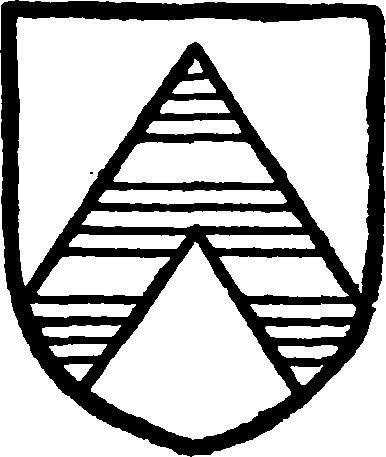
Throckmorton. Gules a cheveron argent charged with three gemell-bars sable.
Manors
In the time of Edward the Confessor 3 hides in ALDWINKLE or HOLLANDS MANOR were held by Peterborough Abbey for the sustenance of the monks, but by 1086 Ferron held them by the king's command, against the will of the abbot. (fn. 3) According to the survey of c. 1125 3½ hides were held of the abbey by Ascelin de Waterville. (fn. 4) Ascelin's son Hugh before 1155 made a composition with Abbot Martin whereby he should hold the manor of Aldwinkle at a rent of 60s. 4d., (fn. 5) From this date the manor followed the descent of Thorpe Achurch (q.v.) to the end of the 15th century. (fn. 6) In 1487, while Margaret Countess of Richmond held it for life, (fn. 7) the reversion of Hollands Manor, in tail male, was granted to John Risley, knt., the king's servant. The grant included woodland called Bareshanke and meadow in Brantsey and Swillyngholt in Aldwinkle. (fn. 8) The Countess of Richmond died in 1509 and John Risley, to whom the manor then passed, died in 1513 leaving no son. (fn. 9) The manor thus reverted to the king, who in this year granted it in fee to Sir William Compton. (fn. 10) He died seised of Hollands Manor in 1528 having a son and heir Peter, then six years old, who died in 1539 and was succeeded by his son Henry, afterwards Lord Compton. (fn. 11) In 1570 Henry Compton, at this time a knight, had licence to alienate Aldwinkle or Holland Manor, to Thomas Cecil, (fn. 12) who became Earl of Exeter in 1605. The manor of Aldwinkle St. Peter afterwards followed the descent of the Earldom of Exeter until in 1773 it was conveyed by Henry Brownlowe, ninth Earl, to Thomas Powys of Lilford, (fn. 13) created Baron Lilford in 1797. (fn. 14) It subsequently passed with this barony.
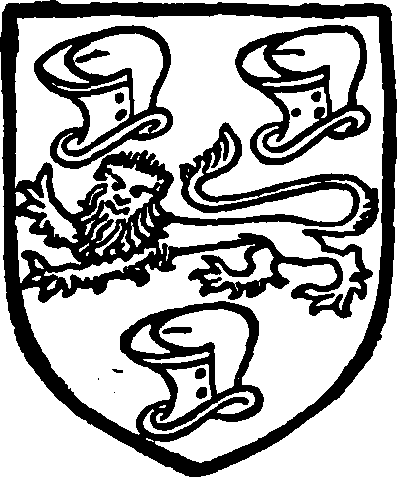
Compton. Sable a leopard or between three helms argent.
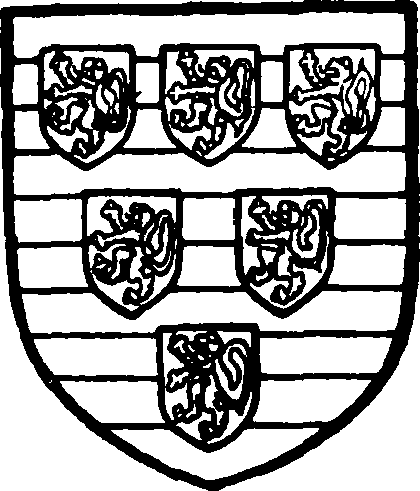
Cecil. Barry of ten argent and azure six scutcheons sable each charged with a lion argent.
One large virgate of land in Aldwinkle was stated in the 12th century survey of Northamptonshire to be held by Geoffrey de Glinton of the fee of Gloucester belonging to the Barton. (fn. 15) In 1285 this overlordship of the earls of Gloucester in Aldwinkle was disputed by the abbot of Peterborough, who alleged that the earl's bailiffs had usurped one-eighth part of the vill of Aldwinkle, which had been wont to answer to the abbot's bailiffs for all that pertained to the king's dues, in the same way as all other vills within the abbot's liberty. Writs of summons were accordingly issued against the earl, (fn. 16) but his right seems to have been maintained, and henceforth it passed with the overlordship of Denford (q.v.). Joan, the widow of the Earl of Gloucester and the king's daughter, was found in 1306–7 to have received yearly rents from Aldwinkle, (fn. 17) and two leets in Aldwinkle were held, as parcel of one-third of the earldom of Gloucester and in right of his late wife Margaret, by Ralph, Earl of Stafford, who died in 1372, (fn. 18) and by succeeding earls of Stafford. (fn. 19) In 1404, Humphrey, Earl of Stafford, being a minor and a royal ward, the king, after assigning a dower to the late earl's widow, granted, from the two-thirds of the possessions of the earldom still in his hands, a leet of the township of Aldwinkle to his consort, Queen Joan, to hold during the young earl's minority. (fn. 20) At the view of frankpledge held at Denford in 1549, Sir Thomas Tresham, Thomas Webster of Barnewell and Richard Webster were presented from Aldwinkle for failure to give suit at the court and were amerced. (fn. 21) Bridges states that two houses in the parish of Aldwinkle St. Peter and two in that of Aldwinkle All Saints were held of the honour of Gloucester in 1723. (fn. 22)
LYVEDEN was partly in the Bassingbourne fee and partly in the Angevin fee of Churchfield, both of which fees were held of the abbot of Peterborough. (fn. 23) It was divided into Upper and Lower or Great and Little Lyveden. The Angevin portion followed the descent of Churchfield in Oundle (q.v.) and the Bassingbourne that of Benefield (q.v.) until the end of the 14th century when in 1372 we find that Walter de Frampton of Melcombe Regis and Margaret, his wife, conveyed the manors of Churchfield and Lyveden with lands, wood and rent in Pottereslyveden, Overlyveden, Lyveden and Lyveden Daundelyn to Richard de Spredlyngton and Roger de Wymondham, clerks. (fn. 24) Possibly the grantees were acting on behalf of Sir John Holt, justice of the Court of Common Pleas, who was in possession of the manors about this time. He was impeached in the Parliament of 1388 and forfeited his lands. (fn. 25) His property, however, was restored to his son John Holt in 1390, except the manor of Lyveden which had been granted to Sir John Devereux, knt., and others to whom it was confirmed in 1392 in payment of debts due from the Crown. (fn. 26) Devereux apparently sold to Sir William FitzWalter, who, with his wife, Joan, conveyed the manor in 1401 to Nicholas de Pye. (fn. 27) Eventually it went back to John Holt, the son, who died seised of rents from the manors of Lyveden and Churchfield in 1419, leaving a son Hugh aged 30 years. (fn. 28) Hugh died in 1420, his heir being his brother Richard Holt, clerk, aged 37 years. (fn. 29) As early as 1458 the Treshams of Rushton were holding the manor. A messuage and lands in Aldwinkle were held by Sir Thomas Tresham, controller of the king's household, who was beheaded as a Lancastrian in 1461. (fn. 30) This property was granted in 1462 to John Donne, usher of the king's chambers, (fn. 31) who in 1465 conveyed it to George, Bishop of Exeter, and other feoffees. (fn. 32) In 1480 it was given by the Crown to William Sayer and Margaret his wife for their lives, (fn. 33) and in 1484 it was granted in tail male to Edward Brampton, esquire of the king's body. (fn. 34) After the accession of Henry VII, however, the manor of Lyveden was restored to John son of Thomas Tresham, (fn. 35) who did homage to the abbot in 1499. (fn. 36) He was succeeded by his son, Sir Thomas Tresham, (fn. 37) who with Isabel Tresham, widow, probably his mother, settled the manor in 1536. (fn. 38) In 1540 Sir Thomas Tresham had licence to impark 120 acres of wood, 250 acres of pasture and 50 acres of meadow in Lyveden commonly called Lyveden Park; the lands abutted on the east on Bareshank Wood and on Whynney Green in Pilton; on the west on the wood called Sherylappe and Sudborough Green; on the south on Sir Thomas's own wood called Ladywood and Bradyhawe, and on the north on the highway called Harlowe Ryding. (fn. 39) Leland wrote 'he caullith himself communely Tresham of Lyveden a 2 miles from Undale in Northamptonshire where yet standithe Parte of auncient Manor Place and godely Medows about it, and there hath Tresham a 300 Markes by the yere.' (fn. 40)
Sir Thomas died in 1547 leaving a son, Thomas, then a minor, who became prior of the order of St. John of Jerusalem in England. (fn. 41) He died in 1558 seised of the manor of Lyveden and was succeeded by his grandson Thomas, son of John Tresham, then under age, (fn. 42) who was later imprisoned several times for recusancy. The New Building at Lyveden was built by him and he laid out the gardens there. (fn. 43) He settled the manor on his wife Muriel and his son Francis, in 1584, and died in 1605. His son Francis, then aged 38 years, (fn. 44) was implicated in the Gunpowder Plot and died in the Tower within a year of his father, his estates having been forfeited. He left no son, but in 1634, after the deaths of Muriel, widow of Thomas, and Anne, widow of Francis, who had interests in the manors under settlements, the manor of Lyveden and other estates were granted to Sir George Simeon and another, (fn. 45) who in that year conveyed them to Francis' brother, Sir Lewis Tresham, and his wife Mary. (fn. 46) Lewis, who had been created a baronet in 1611, (fn. 47) died at Lyveden seised of the manor in 1639 leaving a son and heir William. (fn. 48) The manor had been settled in 1634 on the marriage of William with Frances, daughter of Sir John Gage of Firle in Sussex, on William and his heirs male, with remainder to Toby Tresham and his sons Edward and Thomas. A month before his death, however, Lewis Tresham revoked this settlement for another on William and his heirs. Sir William Tresham died without issue in 1643 leaving as his heirs his sister Mary, the wife of Thomas Lord Brudenell, and the sons of his sisters Elizabeth, Frances, and Katherine, namely, Henry Lord Morley and Mounteagle, William Lord Stourton, and Sir John Webbe, bart. (fn. 49) None of these heirs, however, appears to have had any interest in Lyveden, the limitations under the various settlements being to heirs male. Frances, widow of Sir William Tresham, who in 1649 married George Gage, held the manor after Sir William's death and it was sequestered for her and her husband's recusancy. (fn. 50)
Major-General Butler, the Parliamentary commander, about 1655 attempted to demolish Lyveden House built by Sir Thomas Tresham, but his efforts were in vain, and he was only able to take the timber, which he carried to Oundle to be used for the house there afterwards belonging to Major Creed. (fn. 51)
At the Restoration the manors of Lyveden and Churchfield, with Lyveden House, were said to be in the Crown, either by attainder or escheat, and in 1660 were granted to Edward Earl of Sandwich. (fn. 52) The property, however, was claimed by Maurice, son of Thomas Tresham, and in 1661 he and the Earl of Sandwich were together enfeoffed of it. (fn. 53) In 1667 Maurice Tresham was said to be desirous of selling his part in order to pay his debts, (fn. 54) and he and the earl probably conveyed to George Mathew and Mary his wife, Sir William Smith, bart., of Redcliffe (co. Bucks) and Thomas Rymer, in whose possession the manors are found in 1668. (fn. 55) It is possible these grantees were acting on behalf of William Harbord, of Grafton, the politician and diplomat, who held the manor and died in 1691 at Belgrade on his way to undertake the duties of ambassador at Constantinople. He left by his first wife Mary, daughter of Dr. Arthur Ducks, three daughters, namely, Margaret, the wife of Robert King, second Lord Kingston in the Peerage of Ireland, who died without issue; Mary, the wife of Sir Edward Ayscough, who left two daughters, Letitia, the wife of Lt. Andrew Thornhaugh, and Isabel, the wife of Matthew Bourcherett; and Grace, the wife of Thomas Hatcher, who died without issue; and by his second wife Catherine Russell, he left a daughter Letitia, wife of Sir Rowland Winn of Nostell. (fn. 56) The Harbord co-heirs were dealing with the manor during the first half of the 18th century. The largest share became acquired by the Winns. (fn. 57) Rowland Winn and his wife died at Bath in 1722, and their son Rowland (fn. 58) in 1732 conveyed his share to Anne Fitzpatrick of Farming Woods, widow of Richard Fitzpatrick, Lord Gowran. (fn. 59) She died in 1744 and her son, John Fitzpatrick, created Earl of Upper Ossory in 1751, seems to have purchased the rest of the manors of Lyveden and Churchfield. (fn. 60) He died in 1758, and his son John in 1769 settled both manors. (fn. 61) John the second Earl died in 1818, leaving two unmarried daughters, Gertrude and Anne, known as the ladies Fitzpatrick of Farming Woods. Both these ladies died in 1841, when the manors passed to an illegitimate daughter of the second earl, Emma Mary. In 1823 she married Robert Smith, who took the name of Vernon. He held various ministerial offices and was created Lord Lyveden in 1859. On his death in 1873 he was succeeded by his eldest son Fitzpatrick Henry Vernon, who died without issue in 1900. The manor then went to his nephew Courtenay Robert Percy, son of the Rev. Courtenay John Vernon, sometime rector of Grafton Underwood. (fn. 62)
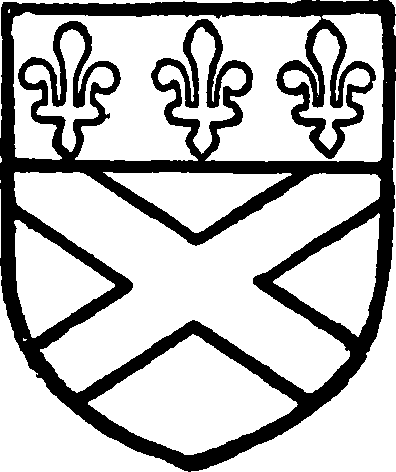
FitzPatrick. Sable a saltire argent and a chief azure with three fleurs de lis or therein.
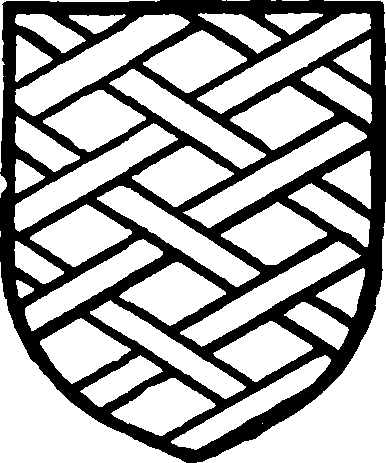
Vernon. Argent fretty sable.
There were several large freeholders in the manors of Lyveden and Churchfield. Matefrei the Dispenser held lands in Churchfield in 1202 and in the time of Abbot Robert de Lindsey (1214–22). (fn. 63) In 1233–4 Richard, son of Simon de Lyveden, conveyed a messuage to his brother Roger. (fn. 64) William Aldwyncle in 1428 held a fourth part of a knight's fee in Churchfield, formerly held by Henry de Wyville, (fn. 65) and Sir John Holond had a free tenement in Oundle formerly held by William de Lyvenden and previously by Sir Reginald de Wadville (Waterville ?). (fn. 66) The Lyveden family held considerable property in the manors. (fn. 67)
Church
The church of ST. PETER consists of chancel 31 ft. by 17 ft. 9 in., with north vestry, clearstoried nave of three bays 36 ft. 9 in. by 14 ft. 8 in., north and south aisles, south porch, and west tower 8 ft. by 7 ft. 6 in., surmounted by a spire. The north aisle is 8 ft. 6 in. wide, the south aisle 10 ft. 6 in., the width across nave and aisles being 38 ft. 8 in. All these measurements are internal.
The tower is faced with ashlar, but the rest of the building is of rubble, with lead covered roofs. There are plain parapets to the chancel, north aisle and north side of the clearstory, but elsewhere the parapets are battlemented. The porch has a plain gable and overhanging stone slated roof.
The earliest work in the present building is the west respond and the western cylindrical pier of the north arcade, which are c. 1180–90. At this time a north aisle was added to an earlier 12th century aisleless building, the nave of which was probably about the same length as at present. The pier has a moulded base and rudely carved capital with square abacus, and the respond a square impost, but no other work of this period survives. The next enlargement was about the middle of the 13th century, when a south aisle was added, and later in the century, c. 1290, the north aisle was rebuilt, the south arcade reconstructed with the old materials, and the aisle widened. The chancel was rebuilt in its present form about 1370–75, and the porch, clearstory, and tower and spire are approximately of the same date. The vestry is contemporary with the chancel. The chancel was restored in 1860, and the rest of the building in 1876, when the north aisle was rebuilt. With the exception of the tower and the west end of the nave, all the walls are plastered internally.
The chancel has an east window of five cinquefoiled lights with vertical tracery, perhaps a later insertion, and is lighted on the south side by three 14th-century windows each of two trefoiled lights with traceried heads differing in design, and one at the west end of the north wall. The sill of the eastern window is lowered internally so as to form two graded sedilia, on either side of which in the window jambs are ogee-headed niches. The moulded piscina is also ogeeheaded and has a fluted bowl. The west window has a transom at the level of the other window sills, which cuts off the lower portion of both lights, one of which (fn. 68) is rebated as a low side window. There is a scroll string all round the chancel externally at sill level. In the north wall is a rectangular aumbry, and a moulded doorway to the vestry, (fn. 69) and west of this a restored wall recess. In the east wall, north of the altar, is an image bracket. The chancel arch is of two chamfered orders with hoodmould on each side, the inner order resting on carved and moulded corbels. The oak chancel screen was erected in 1921.
The north arcade, as rebuilt in the late 13th century, has three pointed arches of two chamfered orders with hoodmoulds, resting at the west end on the square respond and early pier already described. The eastern pier (c. 1290) consists of four attached shafts with moulded capital and base; at the east end the inner order of the arch is carried on a moulded and carved corbel. The hoods have stops over the piers. The cylindrical piers of the south arcade are c. 1240, but differ in detail. Both have circular moulded bases, and the capital of the western pier is also circular and has nail-head ornament. The eastern pier is of slightly less diameter and has an octagonal moulded capital with pellet ornament, and the base stands on an octagonal plinth. The responds are similar to those of the north arcade and all four piers stand on high square plinths, perhaps parts of the walling of the original church. The arches, as on the north, are of two chamfered orders.
In the south aisle are three late 13th-century windows of two lights, that in the west wall with forked mullion and low transom, the bottom lights of which are rebated inside though the sill is over 5 ft. above the floor. The window west of the porch is of two trefoiled lights with a cusped circle in the head, and the window at the east end of the aisle is of the same type, with an image bracket on either side. Next to it in the south wall is a two-light window with 14th-century tracery; its sill is lowered inside to form a seat, at the back of which below the window is a piscina with trefoiled ogee-head and projecting moulded basin carried on a small shaft. The middle window of the aisle is a 15th-century insertion of three lights. The south doorway is modern.
At the east end of the north aisle is a pillar piscina with moulded basin on three clustered and banded shafts with chamfered base and square plinth; the recess has a plain ogee head and the bowl is fluted. More to the north is a 13th-century piscina with trefoil headed recess and bowl in the thickness of the wall. There are two image-brackets in the east wall, the window of which is modern; but with one exception the other windows of the aisle, and the north doorway, are the old ones re-used. The clearstory windows, four on each side, are square-headed and of two trefoiled lights.
The tower is of three stages with moulded plinth, diagonal buttresses and a projecting vice in the southeast angle. The two lower stages are blank on the north and south, but on the west there is an ogeeheaded window of two lights, the mullion and tracery of which are new, and in the middle stage a circular moulded window with modern 'roue tournante' tracery. The bell-chamber windows are of two trefoiled lights with quatrefoil in the head, and the cornice above, from which the graceful broach spire rises, is carved with grotesque heads and birds clinging head downwards. The broaches have small octagonal pinnacles, and there are three sets of spire lights on the cardinal faces. The tower arch is of three chamfered orders on moulded and carved corbels. The doorway to the vice has a shaped and moulded head.
The late 13th-century font is similar to that at All Saints' church, with octagonal bowl and shafted stem.
The pulpit and other fittings are modern.
In the chancel is an elaborate mural monument to Margaret Davenant (d. 1613) with shield of arms, and on the entablature the date of erection 'Anno Domini 1616.'
There is some interesting mediæval glass. In the western window south of the chancel are figures of St. George and St. Christopher beneath canopies, c. 1290, and with a border of alternate white hounds and yellow hares; in the top lights of the east window are figures of two priests, one representing Roger Travers, rector, and the other William de Luffwyck, the builder of the chancel, who was rector 1335–80: both are mentioned by name in inscriptions. The tower window has modern glass commemorating Thomas Fuller.
There are five bells by Taylor and Co. of Loughborough, 1903. A former ring of three (the tenor dated 1585, and the second by Thomas Eayre of Kettering, 1724) (fn. 70) was then recast and a new treble and tenor added.
The plate consists of a cup, paten, and flagon of 1855; there is also a plated paten. (fn. 71)
The first volume of registers contains entries of baptisms from 1563 to 1653, but there are no marriages or burials, the book having been mutilated. (fn. 72) The second volume contains baptisms 1653–1711, marriages 1654–1706, and burials 1653–1678. At the end of the second volume are sixteen pages of briefs.
Advowson
There was a priest among the tenants of the Abbey of Peterborough in Aldwinkle between 1125 and 1128 (fn. 73) and two parts of the tithes were confirmed to the abbot by Pope Eugenius III. (fn. 74) The church was held with the manor in the middle of the 12th century when Hugh de Waterville held them, and they continued to be so held. In 1372 it was found by inquisition that Oliver de Lufwik and Richard, parson of the church of Stanwigg, might assign tenements in Aldwinkle, held of Sir Robert de Holand, to William de Lufwik, parson of St. Peter's church, to provide a priest to celebrate daily at the high altar. (fn. 75) At the time of the Dissolution, the tithes, the rectory house, the land and glebe were worth £11 16s. 8d. a year, whence 10s. 7d. was paid to the archdeacon of Northampton for procurations and synodals. (fn. 76) In 1570, at an episcopal visitation, it was presented against the rector of Aldwinkle St. Peter that 'the parsonage is in decay. And that he helpeth not the poore nor teacheth anie children.' (fn. 77)
In 1602 Thomas Fuller became rector, whose son, born at Aldwinkle in 1608, was Thomas Fuller, author of the 'Worthies.' (fn. 78) Joseph Drury, the distinguished headmaster of Harrow School from 1785 to 1805, held the living for some years on condition he should resign it to the son of Lord Lilford, the patron, but he never lived at Aldwinkle. (fn. 79)
There are no separate charities for this parish. (fn. 80)